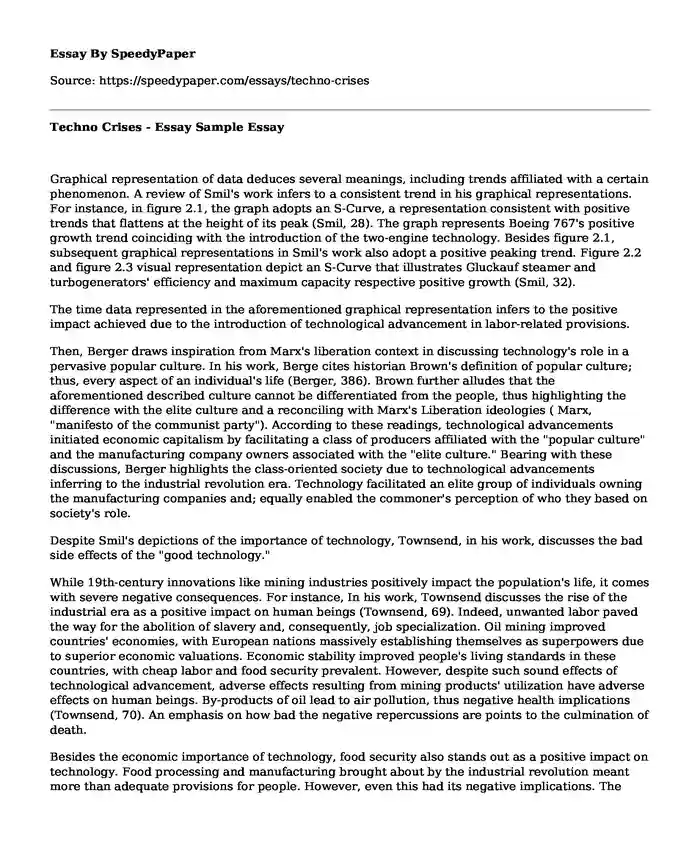
| Type of paper: | Essay |
| Categories: | Technology |
| Pages: | 3 |
| Wordcount: | 719 words |
Graphical representation of data deduces several meanings, including trends affiliated with a certain phenomenon. A review of Smil's work infers to a consistent trend in his graphical representations. For instance, in figure 2.1, the graph adopts an S-Curve, a representation consistent with positive trends that flattens at the height of its peak (Smil, 28). The graph represents Boeing 767's positive growth trend coinciding with the introduction of the two-engine technology. Besides figure 2.1, subsequent graphical representations in Smil's work also adopt a positive peaking trend. Figure 2.2 and figure 2.3 visual representation depict an S-Curve that illustrates Gluckauf steamer and turbogenerators' efficiency and maximum capacity respective positive growth (Smil, 32).
The time data represented in the aforementioned graphical representation infers to the positive impact achieved due to the introduction of technological advancement in labor-related provisions.
Then, Berger draws inspiration from Marx's liberation context in discussing technology's role in a pervasive popular culture. In his work, Berge cites historian Brown's definition of popular culture; thus, every aspect of an individual's life (Berger, 386). Brown further alludes that the aforementioned described culture cannot be differentiated from the people, thus highlighting the difference with the elite culture and a reconciling with Marx's Liberation ideologies ( Marx, "manifesto of the communist party"). According to these readings, technological advancements initiated economic capitalism by facilitating a class of producers affiliated with the "popular culture" and the manufacturing company owners associated with the "elite culture." Bearing with these discussions, Berger highlights the class-oriented society due to technological advancements inferring to the industrial revolution era. Technology facilitated an elite group of individuals owning the manufacturing companies and; equally enabled the commoner's perception of who they based on society's role.
Despite Smil's depictions of the importance of technology, Townsend, in his work, discusses the bad side effects of the "good technology."
While 19th-century innovations like mining industries positively impact the population's life, it comes with severe negative consequences. For instance, In his work, Townsend discusses the rise of the industrial era as a positive impact on human beings (Townsend, 69). Indeed, unwanted labor paved the way for the abolition of slavery and, consequently, job specialization. Oil mining improved countries' economies, with European nations massively establishing themselves as superpowers due to superior economic valuations. Economic stability improved people's living standards in these countries, with cheap labor and food security prevalent. However, despite such sound effects of technological advancement, adverse effects resulting from mining products' utilization have adverse effects on human beings. By-products of oil lead to air pollution, thus negative health implications (Townsend, 70). An emphasis on how bad the negative repercussions are points to the culmination of death.
Besides the economic importance of technology, food security also stands out as a positive impact on technology. Food processing and manufacturing brought about by the industrial revolution meant more than adequate provisions for people. However, even this had its negative implications. The scramble for limited resources for food security purposes led to alliances to facilitate European expansionism (Saha, 5). The formation of these alliances brought about rivalries and, subsequently, tensions among rivalling collaborations. Consequently, resulting conflicts led to world war one, thus a consequence of technological advancement. An emphasis on how bad the Industrial Revolution's effects due to technology infers to the total number of lives lost during the war.
The paper highlights technological discussions by Smil, Berger, and Townsend. Smil's work represents graphical visualizations highlighting the positive impact of technological advancement. Then Berger's work discusses the role of technology in the creation of the two types of culture. His work highlights the rise of the elite and popular culture as a consequence of the industrial revolution. Lastly, Townsend's work deliberates on the harmful effects of good technology. He cites economic progress as a good thing resulting from technology with its adverse effects leading to population and eventual death. Additionally, food security represents a good impact that led to world war 1.
Works Cited
Berger, Molly W. "Popular Culture and Technology in the Twentieth Century." A Companion to American Technology (2008): 385-405.
Marx, Karl, and Frederick Engels. "Manifesto of the Communist Party, Chapter I." Bourgeois and Proletarians Communist Manifesto (1848). https://www.marxists.org/archive/marx/works/1848/communist-manifesto/ch01.htm#007
Saha, Jonathan. "European expansionism." The Encyclopedia of Empire (2016): 1-5.
Smil, Vaclav. Transforming the twentieth century: technical innovations and their consequences. Vol. 2. Oxford University Press on Demand, 2006.
Townsend, Peter. "The dark side of technology." (2019): 1-xi.
Cite this page
Techno Crises - Essay Sample. (2024, Jan 15). Retrieved from https://speedypaper.com/essays/techno-crises
Request Removal
If you are the original author of this essay and no longer wish to have it published on the SpeedyPaper website, please click below to request its removal:
- Preparing for System Implementation. Essay Example.
- Free Essay on Computer Security Incident
- Essay Example on Employee Privacy and Rights
- Free Essay: Computers, Society and Ethics
- Free Essay on Computer Systems: Memory Management
- Essay Sample on Exploring Emerging Networking Technologies: A Comprehensive Overview
- Free Essay on The Future of Innovation: Changing the World with Emerging Technologies
Popular categories




